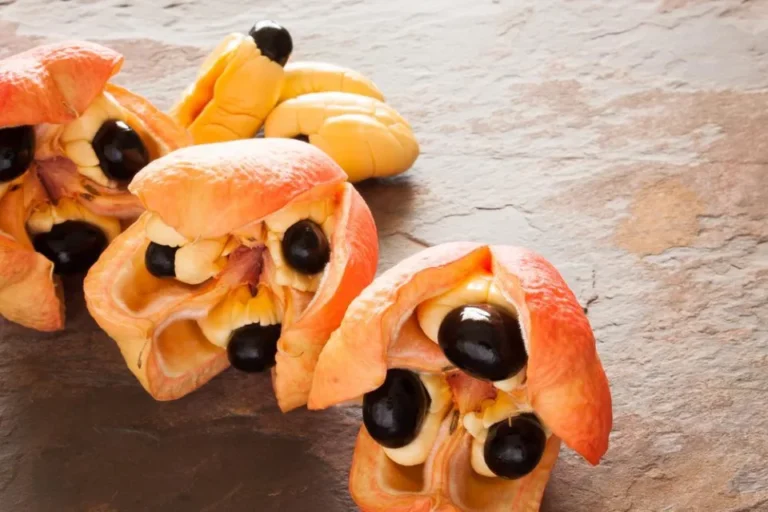Is Ackee a Fruit or Vegetable?
Ackee often sparks curiosity due to its unique characteristics and culinary versatility.
To address this common question: Is Ackee a Fruit or Vegetable?
Ackee is indeed a fruit, not a vegetable.
It belongs to the fruit category because it develops from the flower of the ackee tree and contains seeds, which are key botanical indicators of fruits.
To have a better understanding of whether ackee is a fruit or vegetable, we will delve into its botanical background, explore its culinary uses, and consider its place in a broader context of similarly ambiguous foods.
Botanical Background of Ackee
Definition and Description
Ackee, or Blighia sapida, is an exotic fruit with a distinctive appearance that captivates the eye.
When ripe, the ackee’s outer skin transitions from green to a brilliant red to yellow-orange, and it splits open naturally to reveal three large, shiny black seeds nestled amongst soft, creamy white to yellow arils (the edible portions). Arils are the fleshy parts surrounding the seeds.
These arils have a buttery texture and a mild, almost nutty flavor. The visual contrast between the colorful skin, pale arils, and dark seeds adds to the fruit’s dramatic presentation.
Botanical Classification
Botanically, ackee belongs to the Sapindaceae family, which is also known as the soapberry family.
This diverse plant family includes other well-known members like lychee, longan, and the rambutan.
Ackee shares several botanical traits with these fruits, such as arillate seeds (seeds encased in a fleshy covering) and a similar growth habit.
However, ackee is unique in the family due to its culinary uses and the specific way it must be prepared to ensure safety.
Fruit vs. Vegetable: Botanical Perspective
In botanical terms, a ‘fruit’ is the mature ovary of a flower that typically contains seeds, while ‘vegetables’ are other plant parts such as leaves, stems, and roots.
From this perspective, ackee is unequivocally a fruit because it develops from the flower’s ovary and contains seeds.
The categorization of ackee as a fruit is rooted in its biological development process, where the ovary undergoes changes after fertilization, enlarging and maturing as it transforms into what we recognize commercially as fruit.
This classification is crucial for understanding both the culinary and agricultural aspects of ackee, distinguishing it from true vegetables, which do not originate from the flower’s ovary but from other plant structures.
Culinary Uses of Ackee
Culinary Classification
In the kitchen, ackee is usually treated as a vegetable because it’s often used in savory dishes, even though it is botanically a fruit.
This dual identity in culinary contexts reflects a broader ambiguity that affects several other foods.
While ackee can be used in both savory and sweet dishes, it’s much more common to see it in savory recipes.
Comparison with Other Foods That Blur the Lines Between Fruits and Vegetables
Ackee is not alone in its culinary classification challenge; many plants commonly categorized in one way botanically are utilized differently in the kitchen.
For example, tomatoes are botanically fruits but are predominantly used as vegetables in cooking.
Similarly, squash, cucumbers, and bell peppers are all technically fruits, yet their culinary uses align more closely with vegetables.
This blurring of lines showcases the flexibility in food categories, depending on whether the classification is based on botanical characteristics or culinary practices.
The case of ackee highlights how cultural practices and local cuisines can influence the perception and use of a botanical fruit as a culinary vegetable.
Ackee in Cooking
Ackee’s culinary versatility is celebrated, particularly within Caribbean cuisine, where it is a staple ingredient.
When cooked, ackee’s soft, creamy texture is often compared visually to scrambled eggs, though it doesn’t taste like eggs.
This unique texture makes it suitable for a variety of cooking methods and dishes.
- Ackee and saltfish: The most renowned use of ackee is in the Jamaican national dish, ackee and saltfish. In this dish, the ackee is sautéed with salted cod, onions, Scotch bonnet peppers, tomatoes, and spices, creating a rich, flavorful entree that is beloved both locally and internationally.
- Besides ackee and saltfish, ackee can be used in a variety of other dishes, including stews, fritters, and as a topping for bread or crackers.
- Savory Dishes: Ackee is used in various stews and soups across the Caribbean. It’s sometimes mixed with vegetables like bell peppers and tomatoes, and seasoned with garlic and thyme to create a hearty side dish or main course. In some regions like Jamaica, ackee is also sautéed with bacon or pork, adding a rich depth of flavor that complements its creamy texture.
- Vegetarian and Vegan Dishes: For vegetarian or vegan dishes, ackee is a popular substitute for eggs in scrambles or omelets. It’s often paired with turmeric, onions, and peppers to enhance its natural flavors in these dishes.
- Innovative Uses: Some chefs have begun experimenting with ackee in desserts, utilizing its subtle, slightly nutty flavor in cakes and pastries where it can be a novel ingredient that adds moisture and richness.
Conclusion
Throughout this exploration, we’ve delved into the unique characteristics and culinary uses of ackee, shedding light on why it is classified as a fruit and not a vegetable.
As discussed, botanically, ackee is a fruit because it develops from the flower’s ovary and contains seeds—fundamental characteristics that define fruits.
However, its widespread use in savory dishes often leads to its mistaken identity as a vegetable in the kitchen.
This culinary classification showcases the flexibility and cultural influences that sometimes blur the lines between fruits and vegetables, much like tomatoes and bell peppers, which are botanically fruits but commonly used as vegetables.
The case of ackee highlights an important cultural narrative: how the perception and use of food can be shaped by tradition and culinary practices.
It serves as a reminder that food classification is not just a scientific endeavor but also a cultural one, influenced by the ways in which ingredients are integrated into local diets and cuisines.
By understanding both the botanical background and culinary uses of ackee, we gain a comprehensive view of its role in food science and culture.
Ackee’s story is a fascinating example of how a fruit can play a significant part in the culinary heritage of a region, bridging the gap between what is scientifically correct and what is traditionally embraced.





